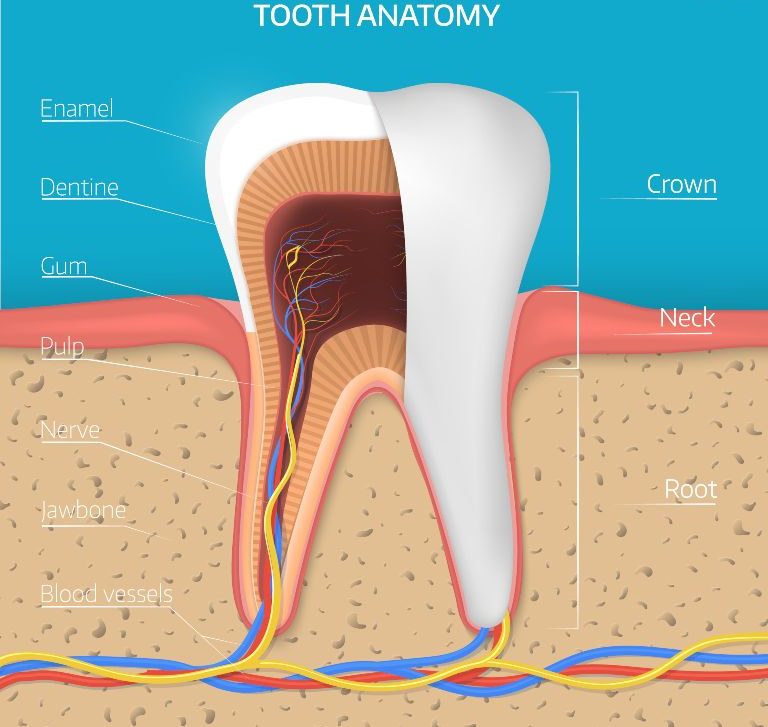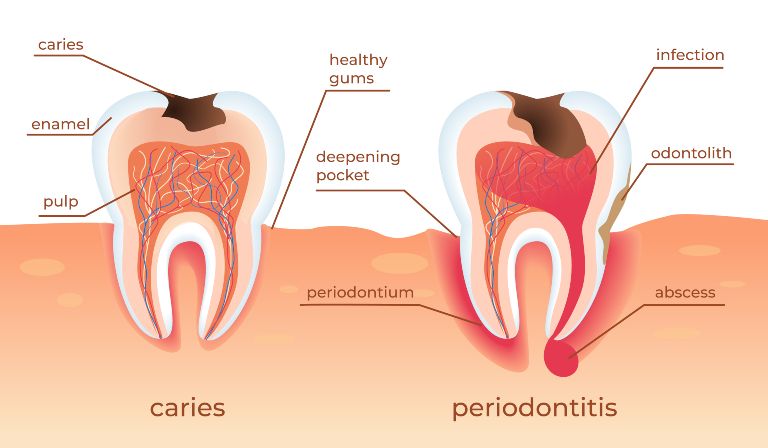The human body is made up of many parts, one of the strongest of which is our teeth. We have multiple types of teeth, and each tooth comes in slightly different shapes and sizes and has a slightly different role to play. When they all work together, they act as a grinder for our food while eating, making the food easier to digest. As a food that enters your mouth is usually too big to digest whole, your teeth take care of cutting up your food so you can avoid the risk of indigestion.
Each human adult has 4 basic types of the tooth;
Each tooth is made up of the same materials that make them strong and healthy, ready to do what they’re meant to do.

To better understand what enamel is, it helps to know each layer of material, or component, which makes up a healthy tooth.
First, we have the crown, which is the top of the tooth. This is generally the only visible part of a tooth.
Our gumline is where our teeth meet our gums. Flossing and brushing regularly is an important part of keeping our gums healthy, keeping them free of plaque and tartar which are elements that can cause gum disease and cavities.
The root is the bottom part of the tooth which, like the roots of a tree, is buried in our gums and holds each tooth in place. The root is the biggest part of the tooth, comprising about two-thirds of each tooth.
The enamel is the outer layer of the tooth and is made up of strong, mineralized tissue. It is the strongest substance in the body and works to prevent decay from entering the tooth.
Next comes the dentin, the layer directly beneath the enamel. If decay manages to wear down the enamel, the dentin is next in the line of fire.
And finally, at the center of every tooth is soft tissue called pulp. This is where the blood vessels and nerve tissue are, and once tooth decay reaches this level you’ll most likely feel pain.
So what is tooth enamel? It’s the outermost layer of a tooth. It’s the very toughest material in the body, even harder than bone.
The enamel on a tooth acts as a kind of armor, protecting it from all the different chemicals which they come in contact with through bodily fluids and food.
Because of this contact with chemicals, enamel can tend to wear down, and when this happens it’s known as enamel erosion.
Once subject to enamel erosion, you may experience symptoms such as unusually strong sensitivity and light yellow tooth stains.

A loss of enamel on your tooth will compromise the rest of your tooth and can result in symptoms such as chips and cracks in your teeth, your teeth turning a darkened colour, indentations on your teeth’s surface called cups, and a heightened sensitivity to temperatures and textures.
If you’re experiencing heavy pain, or these symptoms are more extreme, you might be suffering from more serious enamel erosion.
If left without treatment for too long, complications can arise from enamel erosion like yellowish teeth, fractured teeth, an increase in tooth decay, rough edges forming on your teeth, and odd-looking shiny spots.
Once you lose tooth enamel it can’t be rebuilt or grown back, which is why it’s important to look out for your teeth and make a concentrated effort not to wear down your teeth enamel.
Losing tooth enamel can be caused by several things, one of the key reasons being due to acids found in food and drink. The saliva in our mouths works to protect our teeth by neutralizing these acids, but if you consume excessive amounts of acidic foods and drink and neglect to brush your teeth well and often enough then your saliva won’t be able to keep up with the constant damage.
Foods to look out for include:
Enamel erosion can also occur due to teeth being overexposed to stomach acid. This can happen because of acid reflux, bulimia, or heavy drinking which results in vomiting.

When you lose tooth enamel it puts your teeth in greater danger of tooth decay. Some loss of tooth enamel can occur naturally as you advance in age, but most tooth enamel loss can be prevented by taking good care of your teeth and avoiding sugary or acidic foods and drink.
You can help protect your enamel and keep your teeth healthy and safe from enamel erosion by using fluoride toothpaste and regularly rinsing out your mouth with a fluoride mouthwash. When you use mouthwash with fluoride every day, it works to neutralize plaque bacteria in the mouth which weakens enamel and protects your teeth against cavities in places that would be hard to reach with a toothbrush.
Rinsing your with water after you eat can also help prevent food from getting stuck in between your teeth, which can result in cavities. The water flushes the food out and will also do you some good after a meal.
And, of course, one of the most important parts of oral health and protecting your teeth from enamel erosion is brushing and flossing. Any dentist will recommend that you brush your teeth twice a day and floss once per day.
If you follow these guidelines and pay regular visits to the dentist for routine check-ups, you will be able to avoid enamel erosion.

